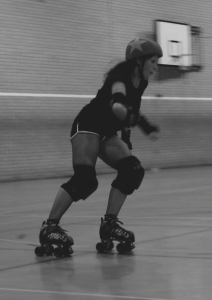The irresistible rise of roller derby
Article published: Wednesday, September 22nd 2010
 Sexy, aggressive, and full-contact: Robin Macdonald reports on a women’s sport with a difference.
Sexy, aggressive, and full-contact: Robin Macdonald reports on a women’s sport with a difference.
Since the foundation of the London Rollergirls in 2006, women’s flat track roller derby has become one of Britain’s fastest-growing sports. A full-contact sport played on quad skates, derby is fast-paced, aggressive and predominantly played by women wearing fishnet tights, miniskirts and eye-catching make-up.
Originally created in depression-era America, the sport was at its peak in the 1950s and 60s when ‘bouts’, or games, were frequently televised. But interest in derby dwindled in the early 80s, and, until its recent revival in America, the sport remained marginal. Today, however, derby is back with a vengeance. Over forty women’s leagues are currently active in Britain and interest in the sport continues to grow.
As a full-contact sport, roller derby gives women the opportunity to excel at a sport in which traditionally “masculine” qualities, such as aggression and strength, are valued. Each player chooses a skate name in order to express their individual derby alter ego. These names, such as Anna Mosity, Emmeline Spankhurst, and Lady Macdeath play on ideas of violence, sex, and death. The message is clear: women who are tough and strong can also be sexy. Some players subvert long-established ideas about gendered sports by bouting in typically “feminine” clothes, including fishnets and miniskirts. But this is not obligatory; women are free to wear whatever they chose in order to express their individuality. “There is no prototype for a Rollergirl”, states the London Rollergirls website, “You do not need to be tattooed or punk, you do not need to be a sports fanatic but both girls fit in fine and both have a home within the London Rollergirls league.”
In fact, in the words of Razor, coach of the Hurl Scouts, the star team of the recent film, Whip It!, “there’s a lot more to derby than fishnets and picking out a tough name”. While some critics condemn what they perceive to be the over-sexualisation of derby players, they fail to recognise that dress is not the most important aspect of roller derby. For many derby players, dress sense is eclipsed by skill, strength and ability. “The game is an amazing show of athleticism”, says skater G Whizz, from Manchester’s newest derby team, the Manchester Arcadians. “[It] is generally treated as such, no matter how much flesh is on display.”
It is the freedom of expression and openness of the sport that attracts many women. According to Amon Amartha, also of the Manchester Arcadians, the derby track is “one of the few places in our society where it genuinely doesn’t matter what your body shape is, every woman has something different to offer.
“Your body is a tool” she adds, “[and] you learn to appreciate what you can do with it and use it in all the ways you can.”
How do you play Roller Derby?
Each ‘bout’ (or game) lasts sixty minutes and is played on an oval track. Two opposing teams (each comprising five players) skate clockwise at high speeds around the track. Each team has a ‘jammer’, who attempts to overtake the ‘pack’ (a group comprised of the other eight players) to score points. To complicate matters, ‘blockers’ from the opposing team attempt to stop the jammer by using ‘hip checks’ and ‘shoulder blocks’ (hits applied with the hips and shoulders respectively). If used correctly, these moves can send players from the opposing team flying to floor and prevent them from scoring points.
Robin MacDonald
This article features in the print edition of The Mule – Issue 10, out now for FREE around Greater Manchester
More: Features, Manchester
Comments
No comments found
The comments are closed.




